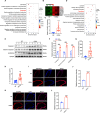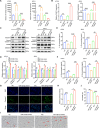miR-126-5p protects from URSA via inhibiting Caspase-1-dependent pyroptosis of trophoblast cells
- PMID: 40372489
- PMCID: PMC12081782
- DOI: 10.1007/s00018-025-05713-w
miR-126-5p protects from URSA via inhibiting Caspase-1-dependent pyroptosis of trophoblast cells
Abstract
Unexplained recurrent spontaneous abortion (URSA) is a distressing pregnancy complication that seriously threat to women's reproductive health. Trophoblast pyroptosis was involved in the occurrence of URSA, but the potential mechanism remains unclear. In this work, we found CASP1 transcription and the level of pyroptosis were significantly elevated in the villous tissues of URSA patients. Suppression of cell pyroptosis by Gasdermin-D (GSDMD) or Caspase-1 inhibitors can reduce embryo resorption rate of URSA mice, while Caspase-1 over-expression in normal pregnant (NP) mice can aggravate embryo resorption. Meanwhile, a pronounced decline in the expression of microRNA-126-5p (miR-126-5p) was found in URSA patients, which was inversely related to CASP1 expression. Over-expression of miR-126-5p restrained trophoblast pyroptosis via inhibiting Caspase-1/GSDMD signaling pathway by direct binding to 3'-UTR of CASP1. Moreover, experiments in vivo substantiated that up-regulation of miR-126-5p effectively suppressed Caspase-1-mediated pyroptosis in placental tissue and significantly reduced embryo resorption rate. Collectively, these results underscored that diminished miR-126-5p expression plays a crucial role in URSA by enhancing trophoblast pyroptosis through activating Caspase-1/GSDMD signaling pathway. As a result, miR-126-5p shows significant promise as a possible biomarker for diagnosis and treatment of URSA.
Keywords: Caspase-1; Pyroptosis; Trophoblast; Unexplained recurrent spontaneous abortion; miR-126-5p.
© 2025. The Author(s).
Conflict of interest statement
Declarations. Ethics approval: All animal experiments were in compliance with the European Community Guidelines for the use of experimental animals, and the guiding principles established by the Experimental Animal Welfare Ethics ReviewCommittee of Shandong University of Traditional Chinese Medicine (Ethical number: SDUTCM20220516004). Competing interest: The author declares that there are no competing interests.
Figures








References
-
- Dimitriadis E, Menkhorst E, Saito S, Kutteh WH, Brosens JJ (2020) Recurrent pregnancy loss. Nat Rev Dis Primers 6:98. 10.1038/s41572-020-00228-z - PubMed
-
- Allison JL, Schust DJ (2009) Recurrent first trimester pregnancy loss: revised definitions and novel causes. Curr Opin Endocrinol Diabetes Obes 16:446–450. 10.1097/MED.0b013e3283327fc5 - PubMed
-
- Rai R, Regan L (2006) Recurrent miscarriage. Lancet 368:601–611. 10.1016/S0140-6736(06)69204-0 - PubMed
MeSH terms
Substances
Grants and funding
LinkOut - more resources
Full Text Sources
Research Materials
Miscellaneous

